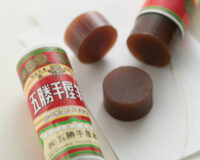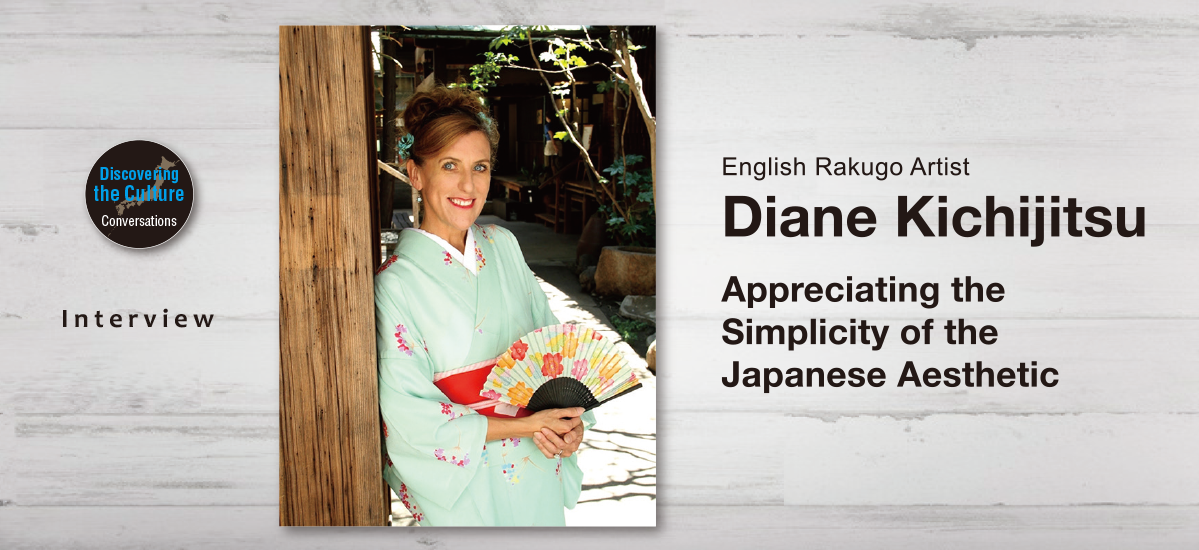
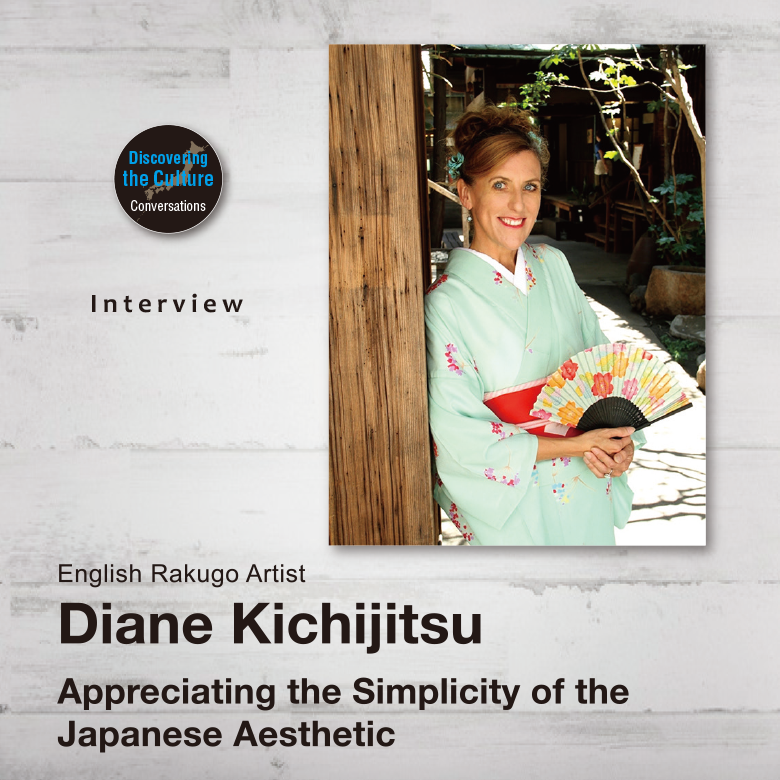
Energetic and outgoing English rakugo artist Diane Kichijitsu shares her fascination for Japanese culture with the world through tea ceremony and her rakugo performance. A licenced kitsuke (kimono dressing) teacher, Diane’s deep love of Japanese culture is evident in the beautiful kimono she wears. Diane, who originally hails from Liverpool, speaks about the aspects of Japan that captivate her.
Text : 中曽根 俊 Shun Nakasone / Photos : 谷口哲 Akira Taniguchi / English Version : Judy Evans
Keyword : Tea Ceremony / Rakugo / Diane Kichijitsu / Ōsaka / Kimono / Ikebana / Wabi Sabi
Diane Kichijitsu
Diane Kichijitsu is an English-language rakugo artist from Liverpool, England. She worked as a graphic designer in London before deciding to go backpacking around the world, arriving in Japan in 1990. Diane began studying rakugo after serving as stage assistant to the late Katsura Shijaku, the pioneer of rakugo in English. Diane performs in both English and Japanese, with a repertoire ranging from traditional pieces to her own, original stories. She adapts her performance to delight people of all ages, from the very young to the elderly. Diane is a sought-after public speaker, regaling audiences with humorous tales of her travels in over sixty countries, and of the sometimes unexpected differences she observes in Japanese culture. In recognition of how far her international activities have helped build a bridge between Japanese and overseas cultures, she was presented with the Nakasone Yasuhiro Incentive Award by the Institute for International Policy Studies (IIPS) in June 2013.
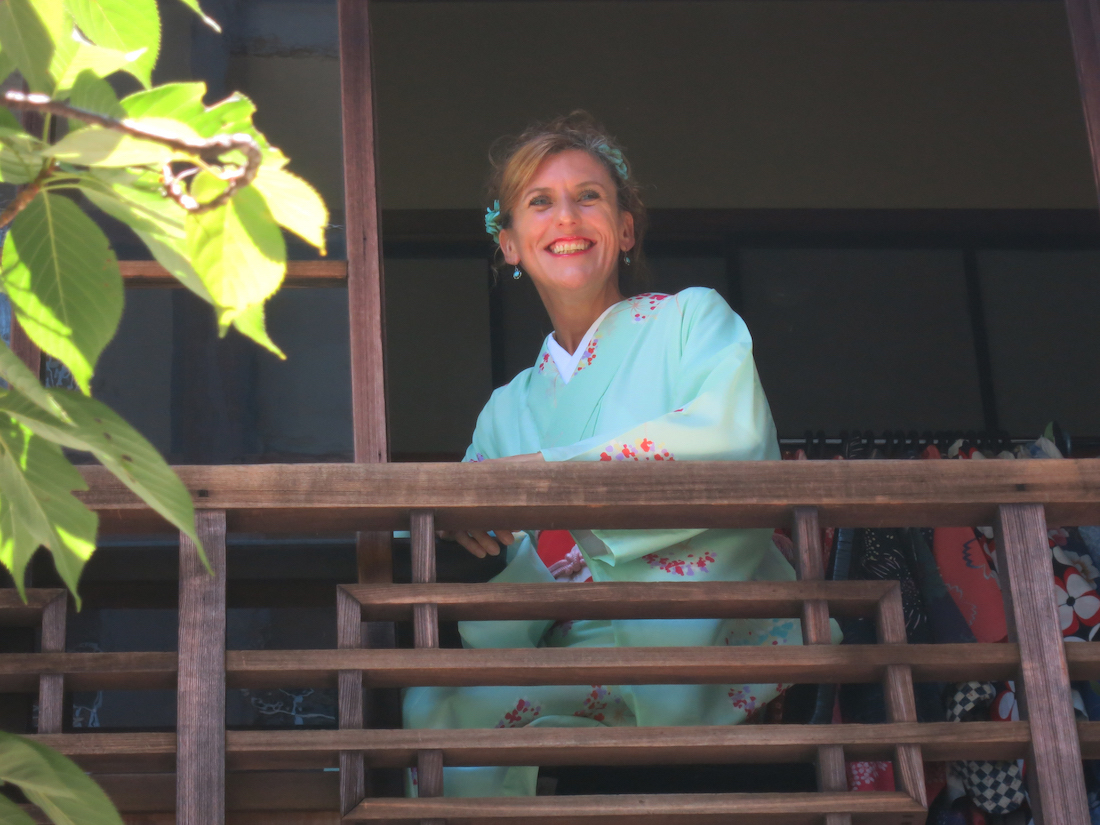
Inspired by the Delicate Japanese Aesthetic
Diane first arrived in Japan in 1990, at the urging of an American workmate she’d met during a working holiday in New Zealand, who had spent a year living in Ōsaka. Arriving in Japan after backpacking through Southeast Asia, she found the country quite different from the other sixteen countries she had already visited.
“Ever since I was little, I’d always liked old places like castles and churches, so, coming to Japan, I was really interested in the rich history and culture here.”
Diane soon began taking pottery classes, then ikebana, tea ceremony and kitsuke (the art of kimono-wearing), delving ever deeper into Japanese culture. It was in Japan that Diane really came to appreciate the beauty of simplicity.
“I was struck by Japan’s delicate aesthetic. Take flower arranging, for instance. Western-style flower arrangements use masses of flowers to create an impact, but ikebana, which is based on a triangular composition, achieves a strong impact without using many flowers at all.”
Diane soon became utterly fascinated by the culture and traditions of Japan, and threw herself into learning as much as she could about every aspect that appealed to her. She became certified to teach both ikebana and tea ceremony.
“These aspects of culture are timeless – they aren’t affected by changing fads and fashions. In the back of my mind was the idea that I could teach ikebana and tea ceremony when I eventually went back to England.”
A turning point for Diane was when she got the opportunity, through a friend’s introduction, to perform the role of *ochako for the late Katsura Shijaku, a renowned Japanese rakugo performer and pioneer of English-language rakugo.
* The ochako (stage assistant) is the person responsible for tasks such as changing the floor cushions and playbills during the performance .
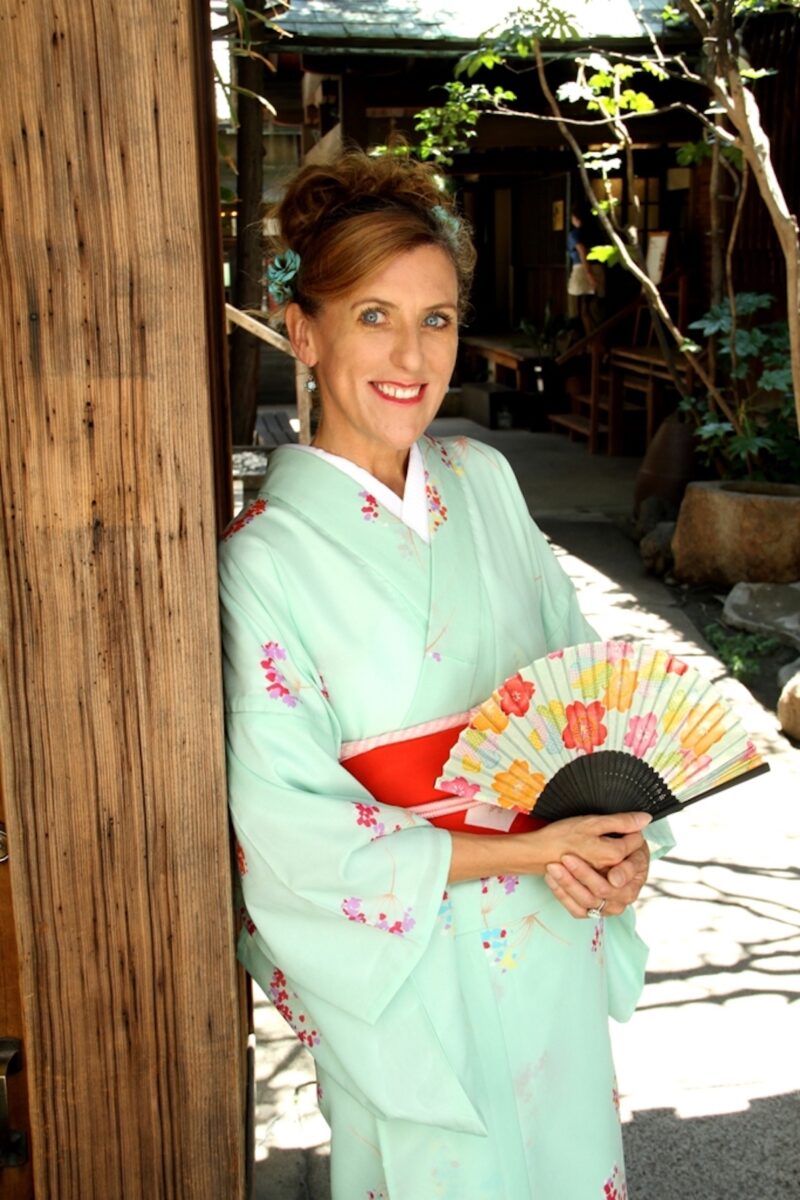
Studying Traditional Rakugo Fully Immersed in a Traditional Japanese Ambience
From the moment she saw her first rakugo performance, Diane was hooked. She immediately wanted to know more about it.
“I started by learning the basics at an English-language rakugo dōjō. I also studied classical rakugo on my own at home, constantly looking things up in the dictionary as I tried to translate it into English.”
A challenge for Diane was the fact that the stories she was translating were set long ago, and the dictionary could only take her so far. Undaunted, she turned to professional rakugo artists for help in making sense of the stories when she was stumped.
Meanwhile, Diane immersed herself in the ambience of traditional Japan, living in a traditional Ōsaka nagaya (row house) and watching samurai dramas on television to learn about the language and customs of days gone by. “I didn’t want just to translate the rakugo stories – I tried hard to also convey the culture and customs of the period in which each story was set.”
One of the challenges in translating rakugo stories into English is what to do when the story deals with, for example, food found only in Japan. Diane encountered this issue with a traditional rakugo story called Scary Manjū. “I wanted to do the story in English, but I knew the audience probably wouldn’t know what a manjū was. It has rice in it, but it’s not a rice cake, and if you call it a bean cake, that just doesn’t convey the sense of what a manjū really is.”
Concerned that she wouldn’t be able to get the audience to visualise a sweet bean and sticky rice cake without adding extra narration, Diane hit upon the solution of simply changing a detail of the story. “Everybody knows what sushi is, so instead of Scary Manjū, I called it Scary Sushi.”
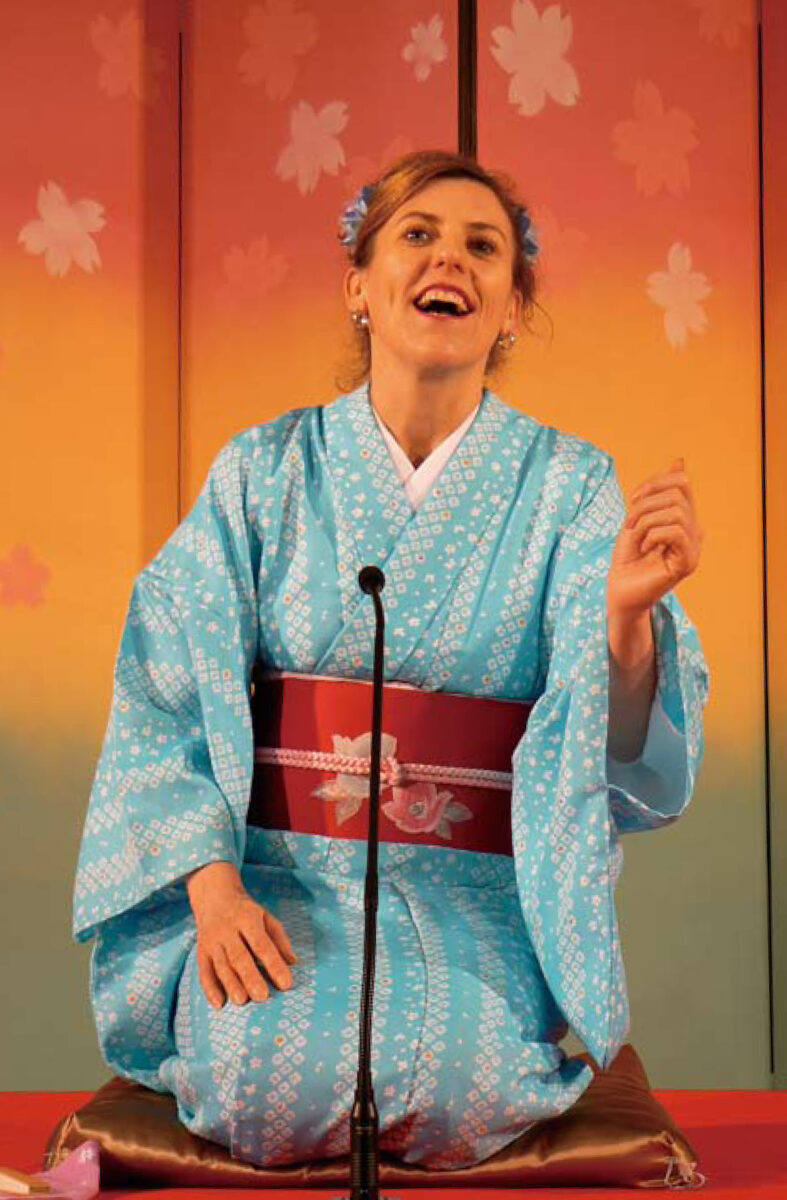
Determined to Share Japan’s Fascinating Culture with the World
Having painstakingly completed her Englishrakugo stories, Diane was thrilled to have the opportunity to perform overseas. She notices that people abroad are increasingly interested in Japanese culture, and are especially curious to see rakugo performed live. Recently in Dubai, Diane found herself in the interesting situation of performing to an audience that included Japanese children born and raised in Dubai. These Japanese children’s first taste of rakugo was with a kimono-clad Liverpudlian performing it in English, in Dubai!
Encountering so many fans of Japanese culture abroad has led Diane to form a new aspiration.
“I want people to know and understand even more about Japan. I’ve found so much value in things like rakugo, ikebana and kitsuke, I’ve learnt so much about it, and I want to share this with the world.”
In order to share her passion and knowledge of Japanese culture in a way that’s fun and engaging, Diane is determined to delve even more deeply into learning about the culture and traditions of her adopted country.
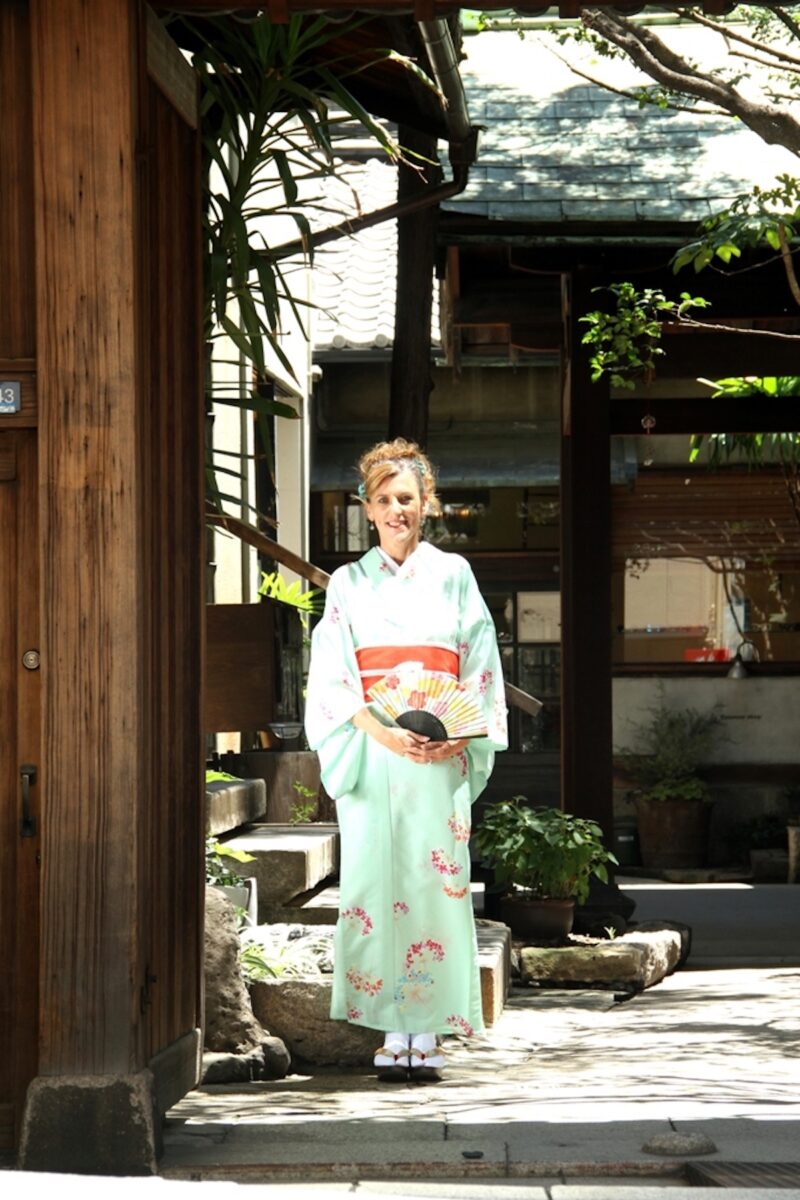
What I love about Japan
Diane Kichijitsu shares with us three of the things she loves about Japan.
1.Kimono
Kimono are something I just can’t live without. Kimono aren’t just for wearing, they’re also lovely to look at. Many of them are works of art in their own right. I first wore kimono when I started learning ikebana and I thought it was just so stylish. They can feel quite restrictive to wear, but I really love the way your posture naturally becomes more elegant in kimono. And when you look at the designs on a kimono, there’s an entire story there, with pictures of trees, rivers and the sky. Then there’s the colour combinations. There are combinations that look absolutely fantastic in a kimono ensemble, that would just never work with Western-style fashions. There’s something about the kimono aesthetic that really appeals to me.
2.Daruma
I always take Daruma dolls with me as gifts when I go overseas. The Daruma doll doesn’t have any eyes, but you colour in one of its eyes when you set yourself a goal. Then, when you achieve that goal, you colour in the other. This concept is really popular with people all over the world. I’ve given Daruma dolls to people when I’ve performed abroad, and they really work hard to achieve their goals and get both eyes coloured in.
The Daruma doll reminds us of the importance of having dreams. In my case, I loved drawing when I was little and dreamed of working as an artist or designer when I grew up. I achieved that goal when I became a graphic designer, and I had other dreams, too. Travelling the world, learning foreign languages, living in different countries…one by one those dreams came true. I want kids to know how important it is to have dreams. You never know how things will actually turn out, but what’s important is to have a dream and follow it, to work towards a goal.
3.Wabi-Sabi
Wabi-sabi is a uniquely Japanese aesthetic that I came to understand through tea ceremony.
I’m really energetic and talkative, but I find a real sense of calm when I’m in the cha-shitsu (tea ceremony space). The only thing on the tatami, apart from the tea utensils, is stillness. I move more slowly than I normally would, and appreciate the feeling of being present, in the here and now, really savouring each unique encounter with my guests.
The dignified atmosphere of the cha-shitsu makes you focus on the hospitality you’re showing to your guests. I really love that feeling – it’s very Japanese.





